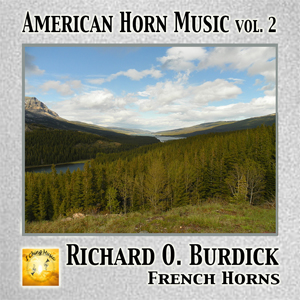

There are eight composer and eleven works on this CD:
Track 1: Richard Burdick’s Piute Flutes for six horns, Op. 217 (1978 - rev. 2016)
Track 2-4 Roger Johnson: Suite for Six Horns (1960 - rev. 1970)
Track 5: Joseph Ott: Acoupleofquickiesforhorns (1977)
Tracks 6-8: William Presser: Horn Trio (1977)
Track 9-14: John Graas: Modern Duets for Horn (1951)
Track 15: John Graas: A Modern Trio For Horns In a Contrapuntal Style (1951)
Track 16: John Graas: A Modern Jazz Theme for Horn Trio Treated in Contrapuntal Style (1951)
Tracks 17-19: Albert, M. Ingalls: Suite for Four Horns (1978)
Tracks 20-24: Albert, M. Ingalls: Divertimento for Three Horns (1977)
Tracks 25: Albert D. Schmutz: Divertimento for four horns (1952)
Track 26: Templeton Strong: Legende fur vier Horner in F (1915)Besides my own composition, this set of American horn music speaks for some of the many forgotten composers of the past. So far, I have not found any work by mature composers that can’t be performed in a musically convincing way. With this set of works my belief is supported.
The most famous composer on this CD is John Graas, famous as jazz horn player, ranked in the top-ten most famous horn players of all time, who recorded with Benny Carter, Stan Kenton, Gerry Mulligan, Shorty Rogers, and Pete Rugolo. Mr. Graas' work sound something like Bach, which give the CD some very nice calm, melodic moments.
Richard Burdick’s Piute Flutes for six horns, Op. 217
My own work fits into this group of works because it is a revision of a work I wrote in 1978. This, even if it were the exact work from 1978 is the newest work of the recording. The title of “Piute Flutes” to me evokes an image of a Sierra Mountain Meadow. In 1978, when I was in High School, I helped at the model railroad at the Alameda County Fairground, and dreamt of building my own narrow-gauge model railroad; the “Piute Line” a name I like. The original duet from 1978 was expanded in 2016 to be a work for six horns as presented here.The Suite for Six Horns by Roger Johnson (1960 - rev. 1970)
This work once again is a nice work but could have been developed more. Roger Johnson was born in 1941 and grew up in San Mateo, California. A composer of serious concert music, electronic music and popular songs; performer on the French horn, piano, and conductor. He studied with Wen-chung, Otto Luening, George McKay, Mel Powell, and John Verrall. Mr. Johnson taught at Ramapo College of New Jersey.Joseph Ott: Acoupleofquickiesforhorns
I did a few performances of Mr. Ott’s work for horn and tape a number of times back in the 1980’s. Mr. Ott (1929 – 1990) was a composer and electronic music pioneer who produced over 400 works.
Throughout his career, Ott received many prestigious honors including a Pulitzer Prize nomination (1985). He was the first American composer to win first prize in the “Citta di Trieste” International Competition for Symphonic Composition (1963) and the first composer of any nationality to give a full concert of exclusively electronic music at the National Gallery of Art in Washington, DC (1977). Mr. Ott held positions at George Washington University, U.C.L.A., Milton College, St. Paul Institute for Advanced Study, The Bennington Composers Conference and was Composer-in-Residence and head of the Music Composition-Theory Department and Electronic Music Studio at Emporia State University in Emporia, Kansas from 1971 until his death in 1990Presser, William: Horn Trio: (1977)
William Henry Presser (1916- 2004) was a prominent American composer, violinist, and a publisher of American chamber music, particularly for brass and woodwinds. Both as a composer and a publisher, he pioneered repertoire for unfamiliar instruments and combinations, such as duets for oboe with trombone, and concert recital works for instruments such as baritone saxophone and alto clarinet. He earned degrees in violin and theory from Alma College, University of Michigan and the Eastman School of Music. His teachers include Roy Harris, Gardner Read, Bernard Rogers, Burrill Phillips, and Pierre Monteux.
Presser performed both as violinist and violist in the San Francisco Symphony and Rochester Philharmonic, and he taught at six colleges. In addition to a long association with the Interlochen summer camp, he taught composition at the University of Southern Mississippi in Hattiesburg from 1953 through 1981.
Over 130 works by William Presser are in the catalogs of twenty publishers. His chamber works for winds and brass are staples of the repertoire, appearing on many contest lists and college recitals.
William Presser founded Tritone Press and Tenuto Publications in 1961 and over 41 years built a catalog of over 350 works by over 50 American composers.[4]Albert M. Ingalls: Diveritmento (1977) and Suite for Four Horns (1978)
These suites are not written by the fictitious character from Little House on the Prairie, but due to his obscurity and the popularity of the TV show I can’t find any information about this wonderful composer,Albert D. Schmutz: Divertimento for Horn Quartet (1951)
Albert D. Schmutz (1858-1975) of Stockton, Kansas was a native of Halstead, Kansas. From 1928-1958 he was the organ and piano instructor at Emporia State College, and also taught at Bethel and Tabor colleges. He was the first instructor of choral music at the National Music Camp, Interlochen, Mich., and continued on the staff there until age 85.Templeton Strong: Legende. Quartett für vier Horner in F (1915)
George Templeton Strong (May 26, 1856 – June 27, 1948) was an American composer of classical music and a professional painter as well. He occasionally undertook engagements as an oboist and English horn player for the Metropolitan Opera Orchestra. His work has been described as Romantic. He moved to Vevey, Switzerland in 1897 and lived there and in Geneva for the remainder of his life. Although his career was in Europe, he is considered an American composer. His father was president of the New York Philharmonic Society, a lawyer, and a friend of Abraham Lincoln.Everything on this CD is older and either has fallen into public domain, or my attempt to contact the publisher has been unsuccessful, I did my due-diligence to pay all royalties owing.
About the Recording:
About the Performer:
Richard Burdick as a musician:
French hornist: Richard O. Burdick is the first horn of Regina Symphony Orchestra and the Regina Symphony Chamber Players in Regina, Saskatchewan, Canada. He is a prolific composer.His move to Canada in 2003, with his wife Rebecca and his two boys, marked the start of the fourth major period in his musical Career.
In the 1980’s Richard was first Horn of Napa Symphony, a member of a San Francisco based theater orchestra and played lots of chamber music as manager of Trinity Chamber Concerts, a chamber music series in Berkeley California.
Starting in 1990 he played fourth Horn full-time for Sacramento Symphony, which went bankrupt in 1996. He then won auditions for Fresno Philharmonic, Napa & North State Symphonies and played in Sacramento Philharmonic & Opera.
He is a prolific composer and has many self produced CD’s of his own compositions, Bach, his classical natural horn playing and multi-track performances of many of his favorite pieces.
He performs on a variety of horns, a baroque natural horn (1720), a classical era natural horn (1800), a romantic era (1840's) natural horn, a single F horn from the 1880's, his main symphony horn is a Brendan Model Finke triple horn.
He has also done many music related jobs such as arranger for Sacramento Symphony, librarian and personal manager for Sacramento Philharmonic, and manager of Trinity Chamber Concerts (chamber music series) in Berkeley, California for 19 years starting in 1984.
![]()
![]()
ISRC
Would you like to comment on this work?We would appreciate comments,
|
|---|
Track |
CD40 – Retrospective II |
Duration |
1 |
Horn Quartet No. 1, Op. 39: I. Allegro Moderato |
1:39 |
2 |
Horn Quartet No. 1, Op. 39: II. Adagio |
1:32 |
3 |
Horn Quartet No. 1, Op. 39: III. Allegretto |
1:55 |
4 |
Horn Quartet No. 1, Op. 39: IV. Allegro Grandioso |
2:26 |
5 |
Horn Quartet No. 2 in Bb, Op. 51: II. Andante |
5:47 |
6 |
Horn Quartet No. 2 in Bb, Op. 51: II. Adagio |
6:10 |
7 |
Horn Quartet No. 2 in Bb, Op. 51: III. Minuet |
4:17 |
8 |
Horn Quartet No. 2 in Bb, Op. 51: IV. Allegro |
5:21 |
9 |
Horn Quartet No. 3 “Quratet”, Op. 136: I. Allegro |
6:19 |
10 |
Horn Quartet No. 3 “Quratet”, Op. 136: II. Heavy |
3:23 |
11 |
Horn Quartet No. 3 “Quratet”, Op. 136: III. Moderato |
2:22 |
12 |
Horn Quartet No. 3 “Quratet”, Op. 136: IV. Allegro |
2:40 |
13 |
Horn Quartet No. 4 “Amram visits Copland’s Tomb”, Op. 149: I. To the Funeral |
4:23 |
14 |
Horn Quartet No. 4 “Amram visits Copland’s Tomb”, Op. 149: II. The Tomb (Artifice II) |
0:48 |
15 |
Horn Quartet No. 4 “Amram visits Copland’s Tomb”, Op. 149: III. “Columns of the Mausoleum” (Artifice II) |
4:01 |
16 |
Horn Quartet No. 4 “Amram visits Copland’s Tomb”, Op. 149: IV. Amram’s Dance (Short Version) |
4:50 |
17 |
Horn Quartet No. 5, Op. 154: I. Moderato |
1:47 |
18 |
Horn Quartet No. 5, Op. 154: II. Andante |
2:21 |
19 |
Horn Quartet No. 5, Op. 154: III. Allegro |
1:39 |
20 |
Horn Quartet No. 5, Op. 154: IV. Allegro |
1:53 |
21 |
Horn Quartet No. 4 “Amram visits Copland’s Tomb”, Op. 149: IV. Amram’s Dance (Full Version) |
8:17 (7:77) |
|
total time: |
74:14 |
